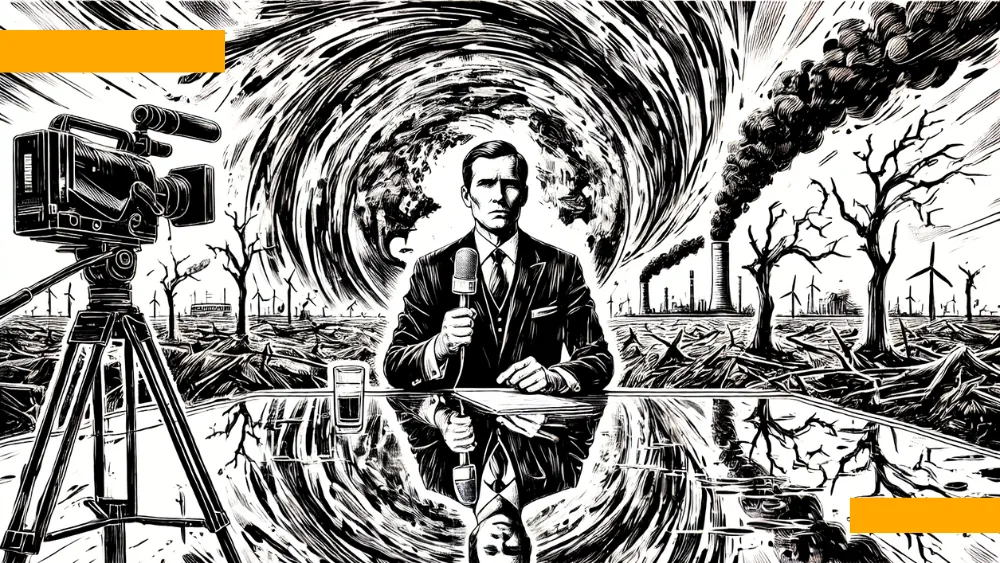 illustration: DALL-E
illustration: DALL-EThe Reuters Institute for the Study of Journalism report, developed by Dr. Waqas Ejaz, Mitali Mukherjee, and Dr. Richard Fletcher, covers research conducted in eight countries (Brazil, France, Germany, India, Japan, Pakistan, the United Kingdom, and the USA), analyzing how often residents encounter climate-related information. It turns out that half of the respondents claim to see, hear, or read climate news at least once a week. This result is almost identical to 2022 (51%) and only slightly lower than in 2023 (55%).
The United States is an exception, where interest dropped drastically - from 50% in 2023 to 34% in 2024. Researchers partially attribute this to the fact that during the data collection period, public attention was focused on the presidential elections, which effectively pushed the climate topic into the background. Meanwhile, in France, where climate change is more present in public debate, 60% of respondents follow climate news at least once a week.
Media vs. Climate Change: How and Where Do We Seek Information?
Although new technologies and social media offer access to an almost unlimited number of sources, traditional media still dominate climate communication. According to analysts from the Reuters Institute, television remains the most popular medium for delivering climate news - 31% of respondents declare that they most often encounter such information there. News portals rank second (24%), while social media comes third (19%).
In countries like India and Pakistan, the popularity of social media as a source of climate information is higher than in Europe or the USA. In India, as many as 43% of respondents admit encountering climate misinformation online - the highest among the surveyed countries.
| Most Preferred Climate Information Formats | Percentage of Respondents |
|---|---|
| Video materials (e.g., TV reports, documentaries) | 51% |
| Texts (articles, reports) | 39% |
| Visualizations (charts, infographics) | 28% |
| Audio (podcasts, radio shows) | 20% |
| Discussions and panels | 20% |
| Interactive content (quizzes, simulations) | 18% |
Interestingly, despite the variety of formats, video materials remain the most preferred - especially in countries like India, Pakistan, and Brazil, where audiovisual content outweighs textual content.
Trust in Media: Scientists at the Top, Politicians at the Bottom
Trust in climate information sources remains stable - 50% of respondents trust the media, similar to 2023. Scientists are the most trusted source of information (74%), while politicians and political parties enjoy minimal trust (25%).
Main Climate Information Sources by Trust Level:
- Scientists: 74%
- Official international institutions (e.g., UN): 60%
- Charitable organizations: 52%
- Climate activists: 45%
- News media: 50%
- Politicians and political parties: 25%
- Celebrities: 24%
Interestingly, the format of information also matters. Video materials are the most favored - 51% prefer watching video reports or documentaries, while only 39% opt for written texts. In the United Kingdom, however, texts remain the most popular.
Climate Misinformation Online: Who Is to Blame?
Although climate misinformation no longer stirs as much emotion as it did a few years ago, it remains a serious challenge. One in four respondents (25%) claims to encounter false climate change information at least once a week.
Climate misinformation remains a significant issue, particularly in countries like India, where 43% of respondents report regularly coming across false information about climate change. Interestingly, misinformation sources vary widely, with politicians and celebrities among the most frequently indicated.
| Source of Misinformation | Percentage of Respondents |
|---|---|
| Politicians and political parties | 12% |
| Governments | 11% |
| Celebrities | 10% |
| Climate activists | 10% |
| Scientists | 8% |
| International institutions | 8% |
| Energy companies | 8% |
| Friends and family | 7% |
| Charitable organizations | 6% |
| Religious leaders | 6% |
The problem is not only the emergence of false content but also its dissemination by public figures and influential groups. The high number of mentions of politicians and celebrities as misinformation sources shows that major media players are not always responsible for misleading the public.

The Future of Climate Reporting
The report "Climate Change and News Audiences 2024" shows that while climate change should be a priority topic, the media do not always manage to effectively engage audiences. Journalists often limit themselves to reporting disasters without explaining their causes and long-term consequences.
Experts emphasize the need for more engaging forms of communication that not only describe disasters but also clearly explain the complexity of the problem. Creating local content that addresses the direct impacts of climate change can help increase interest in the topic.
In the fight for audience attention, the media must rethink their approach to climate coverage. It is essential not only to report disasters but also to show how political decisions and our daily choices impact the planet. Only then will climate change become a constant topic in public debate, rather than just a short-lived alarm after the next catastrophe.
The full "Climate Change and News Audiences 2024" report is available at https://reutersinstitute.politics.ox.ac.uk
COMMERCIAL BREAK
New articles in section Media industry
Advertising market 2025. Poland, Europe and the World
Marcin Grządka
The global advertising market is growing by 8.8% in 2025 and will reach a value of 1.14 trillion dollars. The industry result in Europe records slightly lower dynamics, at the level of 5.8%. In this comparison, Poland performs clearly above the average. We will record an increase of 8.9% this year and a value of 18.56 billion PLN - estimates WPP Media in the annual report "This Year Next Year".
The print media market 2025. Three global trends
Krzysztof Fiedorek
The market value is 359.53 billion dollars, yet the erosion is visible to the naked eye. The decline for newspapers will amount to -2.3 percent. Despite this, print retains strength: it generates 76 percent of subscription revenues and enjoys 82 percent consumer trust. The future of the industry is defined by hybrid strategies and niche specialization.
Journalism in the age of AI. Why people prefer humans over machines
Krzysztof Fiedorek
Only 12% of people accept news created solely by AI, while 62% prefer those written by humans. At the same time, only 19% notice labels indicating the use of artificial intelligence, while younger audiences ask AI to explain the content to them. These are the findings of the Reuters Institute report on artificial intelligence in media.
See articles on a similar topic:
Fake News in Poland. Challenges in Assessing Information Credibility
RINF
One in four information consumers relies on sources where verifying credibility is a significant challenge. Fake news remains a major issue, as indicated by 77% of respondents, with 51% admitting they struggle to discern truth from falsehood, according to Deloitte's *Digital Consumer Trends 2021* report.
Pseudo-democracy and Media - A Few Reflections
Grzegorz D. Stunża
Every four years, citizens are served elections, which are certainly not free. Polls replace part of the electoral process, shaping opinions and voting preferences.
Deepfake Blurs Truth and Falsehood. Human Perception Research
KFi
Studies indicate that only 60% of deepfake images can be correctly identified by humans. As AI begins to dominate content production, the problem of differentiation fatigue grows – users lose confidence in assessing the authenticity of information and fall into cynicism.
Virtual Influencers Perceived as More Authentic than Real Ones
Agnieszka Kliks-Pudlik
Virtual influencers are fictional, generated characters that imitate the appearance and behaviour of real people. They have millions of followers. They are perceived by Gen-Alpha as even more authentic than real people, which creates many challenges, says Dr. Ada Florentyna Pawlak.





























